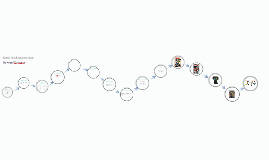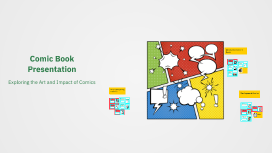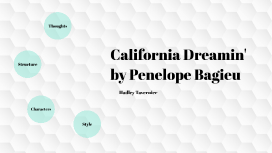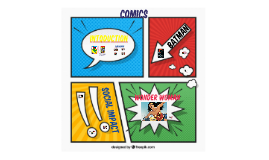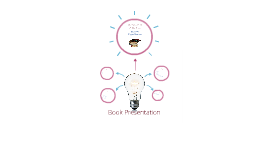Comic Book Presentation
Transcript: Cons: Sexual Stereotyping Cons: Promotion of Violence Globalization Comics "grow up" in film form The history of comic books is split up into different eras: The Golden Age (1938-1949) The Atomic Age (1949-1956) The Silver Age (1956-1970) The Bronze Age (1970-1980) Pros: Comics Help Struggling Readers Minimal opportunity for imagination False reading, it cannot be considered real literature Lack of depth exposition Comic books and graphic novels: Dumbing down the public or providing literary alternatives? A comic book is defined as a “series of words and pictures that are presented in a sequential manner to form a narrative that may or may not be humorous.” (McCloud 1993) It is thought that Europeans of the 16th century were precursors of comic books First official comic was made in 1895 Following this, comic strips became a popular part of newspapers Final Opinions: Colored Intellectual things for Adults Seen as ART 1 or 2 books / year Expensive Works Consulted “Instead of having to be a perfect independent reader, children can look at comics and see visual context,” - Prof. Claudia McVicker, Southern Illinois University at Edwardsville Creates confidence in reading Increases vocabulary through greater context Next step from children’s books Difference of Comics Japanese Comics (Manga) “Comic books have had a motivating power in literacy development for children, especially young boys, since their introduction in the 1930s.” Reading anything requires more critical thinking than just knowing what the words mean. No more wall of text Bridge between reading and a highly visual world Difference between comic books and graphic novels : Comic books are periodicals and are produced monthly, with the stories developing with each new issue Graphic novels are read like a book and complete the narrative by the end Graphic novels mirror traditional book format, while comic book are more simple and held together with staples Comics are symbolic, require visual attention, so everything based off the picture Example: The women of “Archie” o A voluptuous blonde with tight clothes (Betty) o A bodacious brunette with tight clothes (Veronica) o Token unattractive female with a flat chest and buck teeth (Ethel) Standard, superficial roles History and Why It's Important Now Pros: Comics Have Literary Value Monochrome Various genres Romance Adventure Gag & Joke etc… Monthly/weekly comic magazine Not expensive ($3~6) Pros: Comics Make Reading Interesting and Fun Difference of Comics ~American Comics~ Basically colored 75% are about superheroes Using existing superheroes, not original characters Monthly comic book Cheap ($1~3) Other Cons “’Batman’ isn't a comic book anymore. Christopher Nolan’s ‘The Dark Knight’ is a haunted film that leaps beyond its origins and becomes an engrossing tragedy […] This film, and to a lesser degree ‘Iron Man,’ redefine the possibilities of the ‘comic-book movie.’” – Roger Ebert on “The Dark Knight” Comic book movies began in 1940s They largely disappeared until the 1970s 1978: “Superman” became a blockbuster hit and critical success Comic book movies have matured into serious fare 2000s: X-Men, Spider-Man, Iron Man, and the Dark Knight trilogy Graphic novels also turned into serious films Comics and Other Media “If Arkham City was a graphic novel, it would be considered a classic.” – Gamer Limit Comic book video games become respectable Improved technology, same themes Agents of S.H.I.E.L.D, Arrow achieve moderate success Animated comic book programs aimed at kids Gateway to more mature content? Alleyne, Richard. "Comic Books Are Good for Children's Learning." The Telegraph. Telegraph Media Group, 06 Nov. 2006. Web. Bande dessinee: Manga, french style. (2003, Jul 17). The Daily Yomiuri. Web. Retrieved from Box Office Mojo. “All Time Worldwide Box Office Grosses.” Box Office Mojo, IMDB. 2014. Web. Carter, Chris. “Gamer Limit Review: Batman: Arkham City.” Gamer Limit, 24 Oct. 2011. Web. Ciciora, Phil. "For Improving Early Literacy, Reading Comics Is No Child's Play." University of Illinois News. University of Illinois, 11 May 2009. Web. Apr. 2014. Coogan, Peter. 2006. Superhero: The Secret Origin of a Genre. Austin, TX: MonkeyBrain Books. Ebert, Roger. “The Dark Knight Movie Review & Film Summary.” RogerEbert.com, 16 Jul. 2008. Web. Hayman, Greg and Henry John Pratt. 2005. “What Are Comics?” A Reader in Philosophy of the Arts. Ed. David Goldblatt and Lee Brown. Upper Saddle River, NJ: Pearson Education, Inc. 410-424. Hays, Jeffrey. “Manga and Anime Outside of Japan.” Facts and Details, 2013 Web. Retrieved from Kirsh, Steven J. & Olczak, Paul V. “The Effects of Extremely Violent Comic Books on Social Information Processing.” State University of New York, Geneseo. N.p. November, 2002. Web. 05 Apr. 2014. Kuchera, Ben. “Iron Man movie review: comic book movies grow up.” Ars Technica, 5 May 2008. Web. Mcvicker, Claudia J. "Comic Strips as a Text Structure for Learning to Read." The Reading Teacher 61.1






